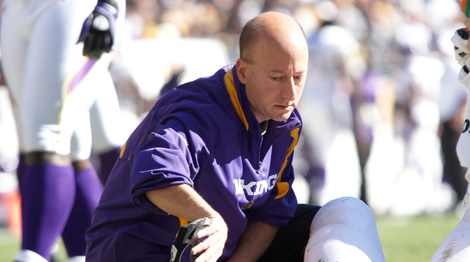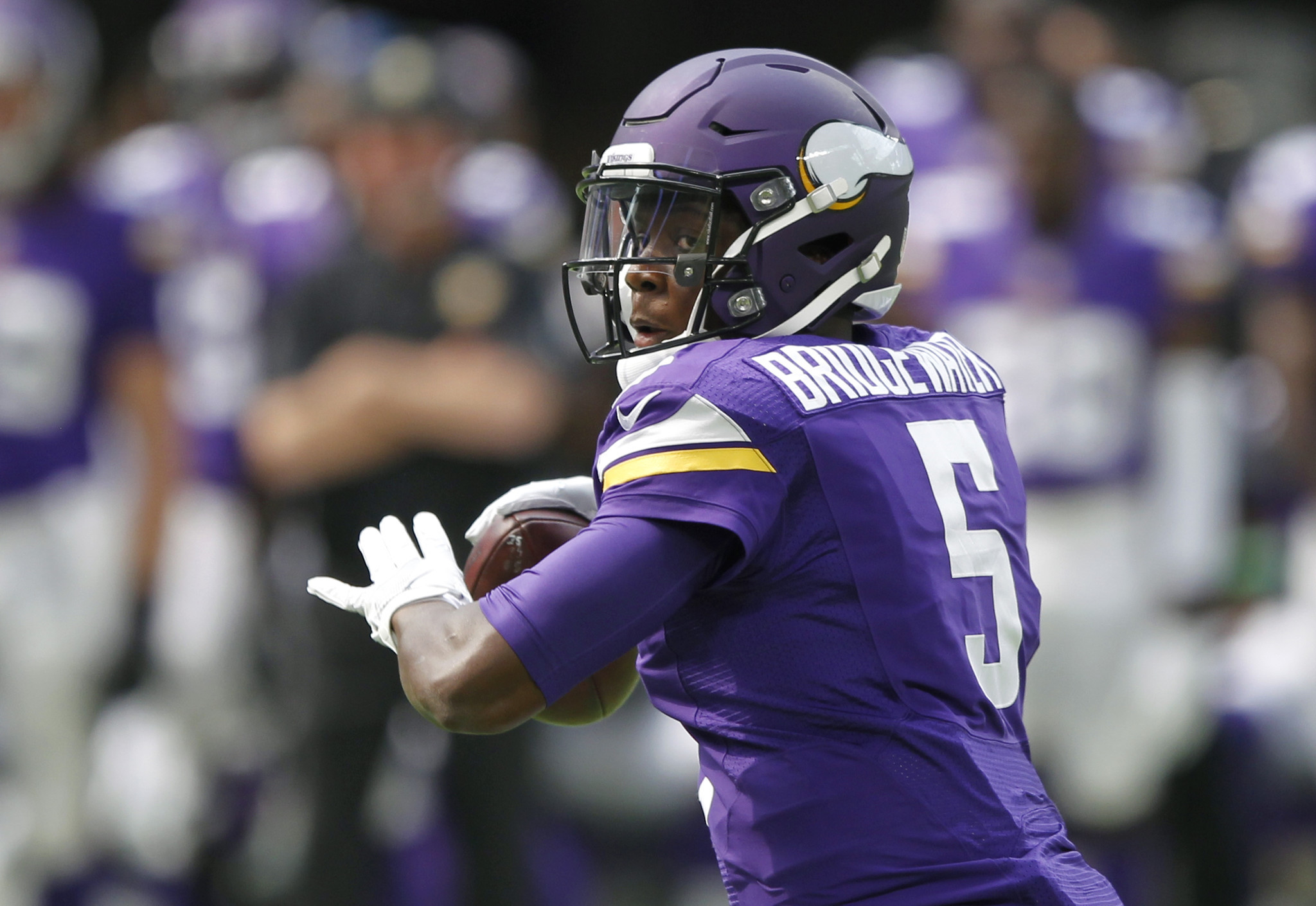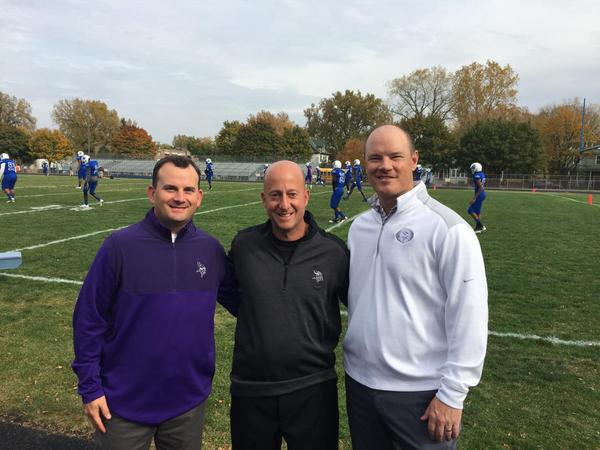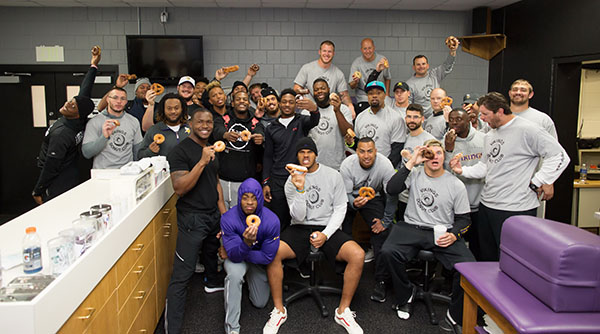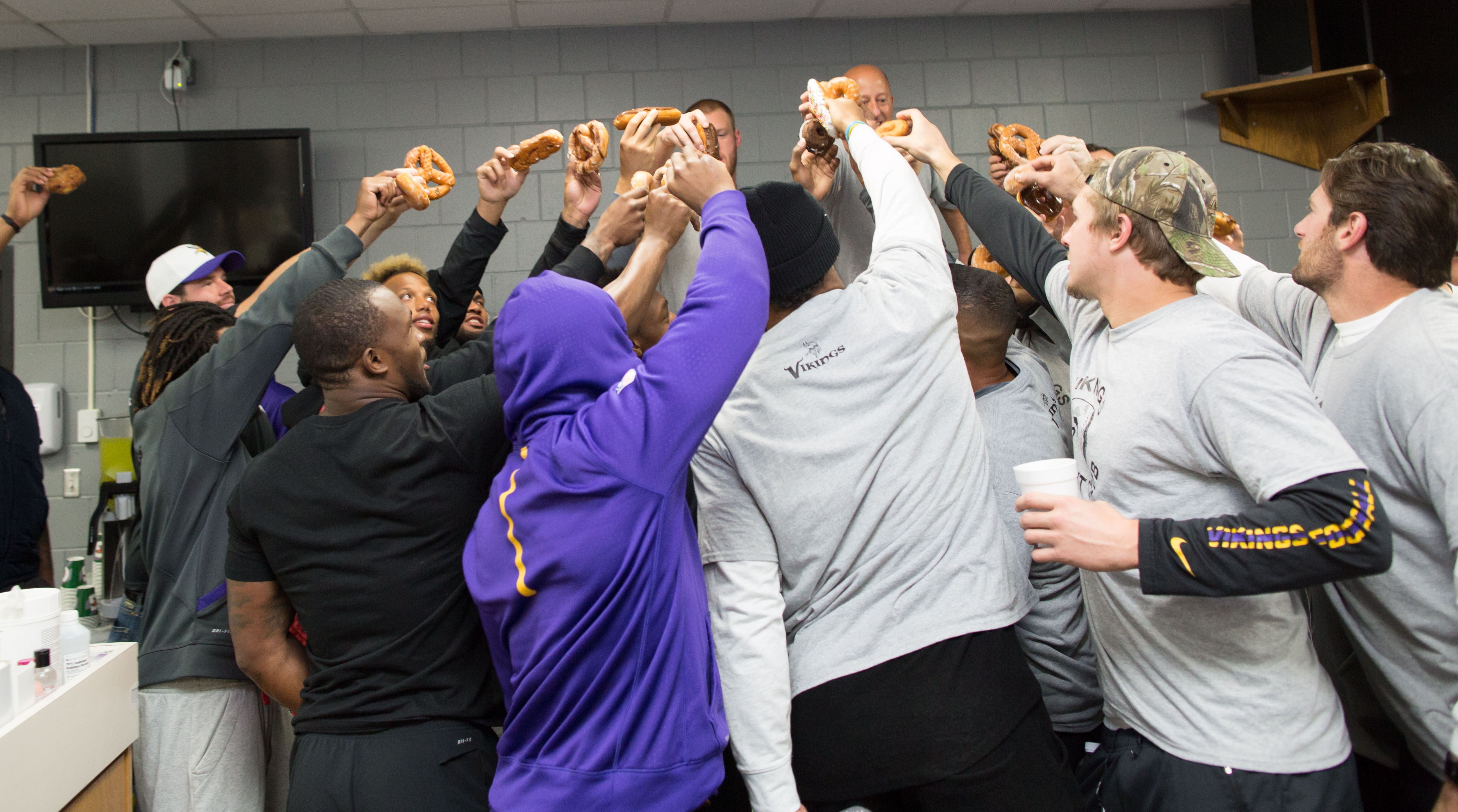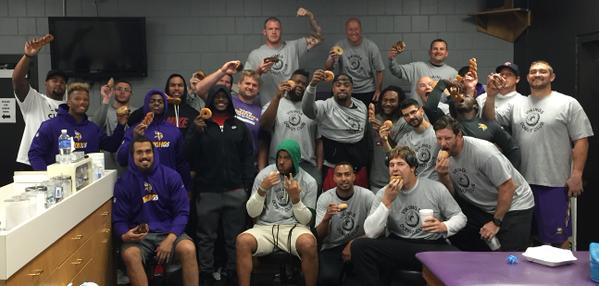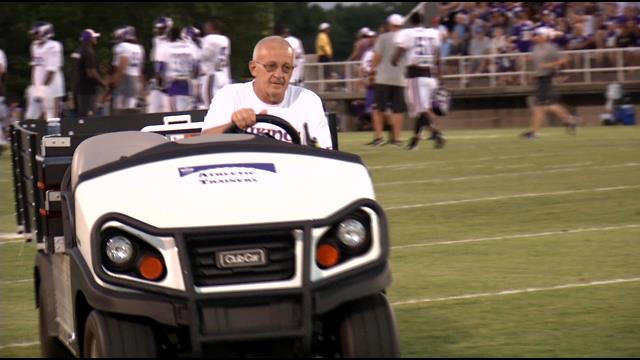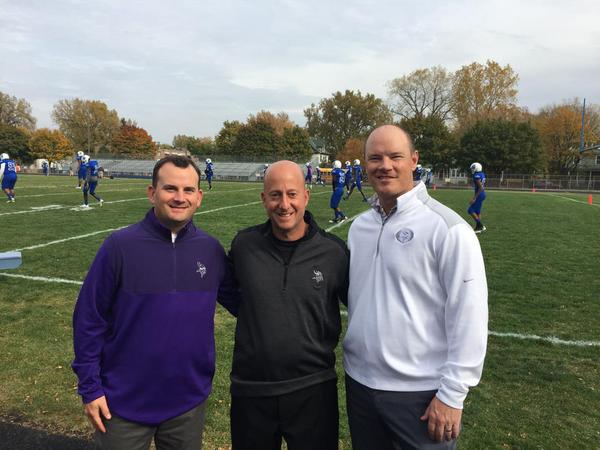
Football players at all Minneapolis and St. Paul public schools received care and treatment from on-site certified athletic trainers for a second straight year thanks to a grant provided by the NFL Foundation and the Vikings in partnership with TRIA Orthopaedic Center.
Vikings Director of Sports Medicine/Head Athletic Trainer Eric Sugarman, who is in his 10th season with the team, has been instrumental in implementing the program.
Sugarman’s interest in sports medicine sparked when he was in seventh grade in Hazleton, Pennsylvania. He became his high school’s first student trainer and learned lessons under Mike Macejko. Sugarman is optimistic that others will be inspired to pursue a career field similar to his. Macejko has reunited with Sugarman to help at each of the past 10 Vikings training camps.
“I think the whole goal of the program is for parents, athletic directors, coaches and the student athletes to understand what an athletic trainer is, understand how valuable an athletic trainer is,” Sugarman said, “and really to get used to and demand an athletic trainer at all high schools in the United States because we’re trying to promote player safety, and this is doing it.”
Prior to the establishment of the grant, one trainer was responsible for trying to cover seven Minneapolis schools. In addition to providing professional staffing, the grant also provides Gatorade and tape from Johnson & Johnson.
Sugarman and his staff — Coordinator of Rehabilitation/Assistant Athletic Trainer Tom Hunkele and Assistant Athletic Trainers Rob Roche, Matt Duhamel and Albert Padilla — are pleased to see the expansion for the betterment of athletes.
Sugarman, Hunkele and Roche recently visited Minneapolis North High School, where ATC Zach Barbur is in his second year of providing assistance to the Polars, to see the program in effect first-hand.
“It gives me pride to talk to Zach and understand that he feels like he’s helping these kids. He’s helping kids that two years ago, didn’t have continuity of care,” Sugarman said. “To do rehab on a daily basis, if it’s just to tape their ankles or treat a concussion, whatever it might be, continuity of care is important, and he’s developed a rapport with these kids and coaches. It’s really a successful program.”
Minneapolis North Athletic Director Leo Lewis, a receiver and return specialist with the Vikings from 1981-91, said the program gives the schools “another part of the sports landscape that has been missing all too long, a professional that deals with some of the concrete realities of playing football: injuries, well-being, the opportunity to get back into play.”
“One of the things the trainer does for us is help build a rapport outside the coaching realm,” Lewis said. “It also serves as a conduit of information because when our young people get injured, they’re not quite sure how to rehabilitate and serve their own. By building that relationship, they can have the confidence that if they are injured, there’s going to be a professional there to give some sound advice.”
Lewis is optimistic that students who are benefitting from the treatment will consider athletic training as a career path.
Barbur, a graduate of Eden Prairie High School and Augustana University, first gained interest in sports medicine during his senior season of high school while he recovered from a broken leg. The hours of rehab work increased his understanding of the important assistance that athletic trainers can provide, which piqued his interest. Barbur has worked to build relationships with the athletes.
“I think last year was a little tough. I was an outsider coming into their program,” Barbur said. “They were having success. They didn’t really know who I was. I think the perception at first was that maybe I’m the guy that’s going to tell them they can’t play, so they don’t want to come talk to me. After I built that trust and worked with them, got to know them, showed them I cared, they truly opened up. They come to me for anything and feel comfortable, so it’s been a breakthrough and it’s fun.”
Personally, the experience through the grant program has heightened Barbur’s passion for athletic training. Professionally, it’s helped create a network with trainers at other schools in the Minneapolis and St. Paul districts.
“It’s nice when I send my athletes to a game across town, I know they’re going to be covered and we have good communication with the athletic trainers there,” Barbur said. “I know that the continuity of care is there as well, that they’re going to get the attention they need and deserve.”
ATC Chris Walker, Supervisor for Sports Medicine Outreach at TRIA, had a similar experience to Barbur, suffering a back injury at practice in his junior season at St. Paul Central High School. He tried to return for his senior season, but didn’t have the benefit of an athletic trainer to guide him through the recovery.
“Going through that was tough, but it opened up a new resource to me. I found this career field and pursued it, and it’s really fun to be back here [after 10 years of working out of state],” Walker said. “One of my assistant coaches from when I played is the head coach now, and to go back and see him and how happy he is to have an athletic trainer on a daily basis, it’s awesome.
“On the other end of it, you know now that these kids are getting the care they need,” Walker added. “They have someone there to help them and get them well. It’s awesome to see the change that’s happening at this level. I think the Vikings and the NFL are an integral part of this program.”
Sugarman said it was great to see young people learn directly about the positive effects of athletic training the way he first did.
“I’ve been very active in the program because I have a passion for my field and a passion to develop young athletic trainers and most importantly to take care of kids,” Sugarman said. “It all starts at this age and younger. I have young kids at home and I watch their football games and make sure they get the proper care they need. It’s rewarding to see these kids get the care they deserve because everyone deserves proper medical care.”
Additional testimonies:
TRIA Sports Medicine Program Manager Amy Hamilton, MA, ATR, ATC:
TRIA Orthopaedic Center is proud to participate with the Minnesota Vikings in The NFL Foundation’s certified athletic trainer grant initiative for the second year. The grant program was established by the NFL Foundation in partnership with the league teams to help fund appropriate athletic training care for schools or teams. The Minnesota Vikings were one of the first teams to step up to participate in the matching grant program. Both the Minneapolis and St. Paul public schools were selected as the recipients of the grant and TRIA was selected as the medical provider. This program is offering us the opportunity to continue to reach out to our communities in the Minneapolis and St. Paul school districts and build upon the progress we made last year in providing these student-athletes with quality care.
These are two of the largest school districts in the country who went from having sporadic medical coverage for their student-athletes prior to the grant program to consistent care on a daily basis this year. All 14 schools across the two school districts now have Certified Athletic Trainers at their schools for practices and games. With the partnership of NovaCare Rehabilitation in two of the Minneapolis schools and HealthPartners Orthopaedics and Sports Medicine in three of the St. Paul schools, TRIA’s sports medicine outreach program is proud to offer high quality, reliable, and professional athletic training services to the high school athlete. The athletic trainers are a team member at their schools who offer a high level of customer service along with the highest level of medical care to their student-athletes through injury and illness prevention, evaluation and treatment, management of medical emergencies, rehabilitation, and safe return to play. We also offer additional services to assist the schools in maintaining the highest standards of care through education on concussion and other hot topics for athletes, coaches and parents as well as injury prevention programs, up to date emergency action plans, and team physician resources.
As the community leader in sports medicine, TRIA along with our partners, are pleased to join the Vikings and the NFL, to ensure we are leading in this initiative to support athletics participation, and improve the health and safety for our student-athletes.
Washburn Head Coach Ryan Galindo:
Reggie Ronning is a consistent and reliable worker in the Washburn High School football program, as well as our other sports programs. He is knowledgeable in athletic training, and displays a great ability to work and build relationships with our student-athletes. His number one concern is the safety of our student-athletes, and he displays this on a daily basis. This service provided by TRIA has greatly improved student-athlete safety, decreased rehabilitation time, and improved injury treatment and prevention. It is an excellent service that is much appreciated by coaches and student-athletes!
Samantha Kieser, MS, ATC, Humboldt High School:
My passion for athletic training came about after tearing my ACL in high school. An athletic trainer played an important role in my recovery, and I strive to provide the same support for the athletes I am working with. Athletic training grants the opportunity to educate athletes, coaches, and parents about how to be safe, healthy and about injuries, something I value and see as extremely important. Last year the NFL grant allowed Humboldt to have an athletic trainer but only to cover football. In one year, everyone recognized the importance and benefit of an athletic trainer. As a result, all sports have access to an athletic trainer on a daily basis this year. In my first year, I provide medical coverage at practices and some games. The athletes appreciate and are excited to have easy access to medical care and someone who is trained in treating injuries.
Naga Rumicho, ATC, Patrick Henry:
Six years ago as a student at Minneapolis South High School, I was a two-sport athlete in football and track, yet had no idea what an athletic trainer was or what they did. The Minneapolis Public School System had one athletic trainer for all seven of their schools; so to be seen by the athletic trainer at the time was almost pure luck. At the time, there was no district funding for athletic training services. Today each school has a designated athletic trainer to manage the health care of roughly 100-200 student athletes on 16 different sport teams which is still a lot to manage but an improvement from what it was.
… After competing in track and becoming interested in athletic training because of its benefit to treat multiple injuries, Rumicho has returned to the Twin Cities as athletic trainer at Patrick Henry. …
This is my second year as part of the NFL Grant Program contract and I love every minute of it. It is very rewarding to provide medical care to my own community so that kids can receive the medical attention they need. The people that I work with at Henry are absolutely amazing. My Athletic Director Guillaume has a big heart for all of his athletes; he is constantly going above and beyond to make sure they have what they need to succeed. Our coaches invest a lot of time and effort not only into making the kids better athletes, but also outstanding human beings. The kids are willing to learn and do the more challenging tasks both on and off the field and I believe it is a product of being part of the community at Henry.
Christina Hirsch, ATC, Johnson High School:
Having athletic trainers in the city schools has been amazing on so many different levels. From injury evaluation, to directing medical referrals, to patient education, our presence is starting to impact student athlete health for the better. For instance, one of athletes sustained an injury during a game and was referred to see a sports medicine physician for imagining. This athlete reported back to me on what the physician told him and we created a tentative plan. However, when I read a copy of the results I noticed that my athlete over-looked a huge piece of their diagnosis. I was able to educate him on how this new piece of information influenced our plan and if certain steps were not followed, it could delay or hinder proper recovery. It was a big “ah-ha” moment for this student. Being at the schools daily because of the NFL and Viking’s athletic training grant program has allowed athletic trainers to provide ongoing care and vital education to student athletes, as well as to be an easy access resource for coaches, athletes, and parents. TRIA’s relationship with the city schools is still in its infancy and I cannot wait to see how sports medicine grows in the schools in the future.
Being the first athletic trainer to have the opportunity to work in a school that has never had the luxury of an AT on sight daily is a terrifying, yet exhilarating, experience. I was afraid of the resistance I might face from the school and the coaches. Would they ignore my medical opinion on injuries? Would they not send an injured player to me for evaluation? Would they shut down injury prevention ideas I had? I was completely wrong; in fact, it was just the opposite. Since the first day of preseason, the community at Johnson High School has been so welcoming and thankful to have an athletic trainer on site. The administrative staff and coaches are thrilled to have someone at the school to evaluate injuries and help manage the recovery and return to play process. There is not a day that goes by where I don’t have an athlete, coach, or parent thank me for what I am doing or tell me how happy they are to have someone on the sidelines at practices and games to care for the medical needs of their athletes. One coach even told me, “It seems like we have had more injuries than ever, but I think it just seems that way because now the kids have someone to talk to about them.”
ORIGINAL ARTICLE:
http://www.vikings.com/news/article-1/VikingsNFL-Grant-Boosts-Health-of-Athletes-in-Year-2/27e28746-ee69-43a6-89db-2bc2d4d66392

